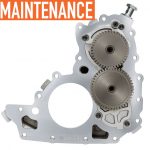It can be a challenge to uncover the actual fuel efficiency value of a new technology, a change in operating practices, or even the impact of driver training. To make informed decisions, fleets need accurate analytics capabilities.
In its Determining Efficiency Confidence Report, the North American Council for Freight Efficiency and the Carbon War Room identified different testing methods for assessing fuel efficiency and detailed the factors fleets should be aware of when interpreting results from each type of test. It concluded that there is no single correct method for fuel economy evaluation and that each test has costs and complexities that need to be considered.
IMPORTANT FACTORS
Computer model, wind tunnel, and test track evaluations all have a role to play in helping fleets make more informed fuel efficiency technology investment choices. Adding a higher level of granularity by incorporating data from true on-road sources, however, should also be considered to accurately quantify performance and the potential payback of any fuel saving solution.
Among the testing methods discussed in the report, on-road testing is a key factor in achieving a fleet-specific view of the performance of a particular technology. For multidimensional data visibility, things like weather, terrain, road, and traffic conditions, as well as issues related to duty-cycle, vehicle specifications, and configurations should all be mixed into the assessment.
“Accurate data from vehicles captured during actual operation is the key to achieving a high level of statistical control and feedback when measuring the effects of fuel efficiency on a given technology or approach,” says Lloyd Palum, chief technology officer at Vnomics Corp, the provider of advanced analytics solutions that enable fleets to improve driver and vehicle performance in real time.
“To effectively and accurately determine driver fuel efficiency, actual fuel usage should be precisely measured in real time,” Palum states. “Actual fuel use can then be compared to the maximum fuel economy the vehicle could achieve under current conditions. Comparing this potential mpg to actual fuel economy provides a normalized metric of fuel use.
“The key,” Palum continues, “is to understand not only what was achieved but also what was possible under current operating conditions. That insight is required to definitively assess fuel economy. With clear visibility into operations and costs, fleets can make informed and calculated decisions leading to improved profitability.”

Fleet managers can use the Vnomics web portal to access comprehensive fuel use analytics and summary dashboards.
FAIR & BALANCED FUEL EFFICIENCY RATINGS
Any professional driver will tell you that mpg is an unfair measure of who is a good driver, Palum notes. “Drivers are not completely in control of the characteristics of a given vehicle or where it is in its lifecycle, as well as a myriad of external factors such as load, weather, traffic, terrain, and auxiliary power usage, all of which directly affect mpg,” he states. “Given the right data analytics, these shortcomings can be eliminated with balanced and normalized scoring.”
By taking into account the minimum fuel usage that is possible for a given vehicle, considering all factors and measuring what was actually achieved, Palum explains further, a fuel efficiency measure that is more fair and representative of true driving performance can be realized.
For example, a fleet has three different drivers running out of the same terminal. All three drivers have different mpg ratings and operate different vehicles, with different loads, on different routes:
- Jeff, driving a 2008 model year truck hauling mixed weight loads and making local deliveries, has a 7.2 mpg average
- Dave, driving a 2012 model year truck on linehaul routes with lightweight loads, has a 6.5 mpg average
- Sue, driving a 2015 model year truck on linehaul routes hauling heavy loads, has a 6.1 mpg average

To determine who is the most fuel-efficient driver accurately and fairly, it is essential to know the maximum potential mpg each driver could have achieved. Considering vehicle specifications, loads, and routes:
- Jeff’s potential fuel economy = 7.5 mpg
- Dave’s potential fuel economy = 7.2 mpg
- Sue’s potential fuel economy = 6.2 mpg
Given this very specific understanding of fuel use, it is clear that Sue is the best driver of the three because her actual fuel economy is within 1.6% of potential mpg. By contrast, Dave is 9.7% from potential mpg and Jeff is 4% away from achieving his potential fuel economy.

Vnomics True Fuel standalone fuel optimization solution.
SOPHISTICATED ANALYSIS
“It takes sophisticated vehicle-specific learning approaches to map and track potential so that each driver is rated based on what was possible under current operating conditions,” Palum says. “Providing that level of insight, by indicating exactly how fuel is used, requires a unique way of measuring fuel use in a mobile asset. Each driver may not drive the same. Loads and routes, along with weather and traffic conditions, may not be the same.”
Precise measurement that takes into account all of these conditions as they are happening is a key attribute of the recently introduced Vnomics True Fuel standalone fuel optimization solution. The system improves fuel economy through real-time driver coaching and comprehensive fuel use analytics for fleet managers.
True Fuel is a driver coaching and analytics tool that can be used regardless of a fleet’s telematics platform. The fuel optimization technology, which has already been proven on several thousand vehicles to provide a three to 10% fleet wide fuel savings, monitors each vehicle’s actual fuel usage in real time and compares it to the maximum achievable fuel economy for that vehicle under its current operating conditions. The system takes into account the impact of vehicle make, model, age, terrain, and load size.
True Fuel provides drivers with audio alerts for improper engine speed control or shifting of manual transmissions, speeding, and idling that signal only when the driver is not optimizing fuel consumption. Drivers are also provided with fair and balanced scorecards detailing the fuel loss factors they can control. Fleet managers can use the solution’s web portal to access comprehensive fuel use analytics and summary dashboards to gain insight into fuel usage and causes of wasted fuel for a fleet or for specific vehicles and drivers.
ABOUT THE AUTHOR:
Seth Skydel has more than 30 years of truck related publication experience. He has held editorial roles at numerous national business-to-business publications focusing on fleet and transportation management, vehicle and information technology, and industry trends and issues.
_______________________________________________________________________
MODERN WORKTRUCK SOLUTIONS: MAY 2016 ISSUE
Did you enjoy this article?
Subscribe to the FREE Digital Edition of Modern WorkTruck Solutions magazine.
![]()




